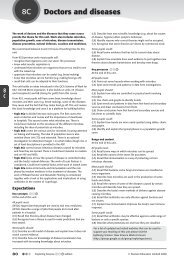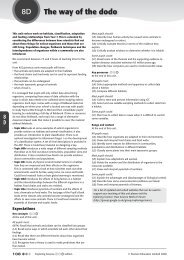8E TEACHER GUIDE.pdf - swallowhillresources
8E TEACHER GUIDE.pdf - swallowhillresources
8E TEACHER GUIDE.pdf - swallowhillresources
- No tags were found...
Create successful ePaper yourself
Turn your PDF publications into a flip-book with our unique Google optimized e-Paper software.
<strong>8E</strong>dWhat’s in a solution?<strong>8E</strong>d3: Practical: Getting it rightWorksheet <strong>8E</strong>c(3) lists some mistakes that could be made whencarrying out chromatography, and asks pupils to suggest whatcould happen if these mistakes are made. This sheet could justform the basis for individual work or a class discussion, or theanswers to the questions could be treated as predictions thatpupils can then check.Resources (per group)Water-soluble and permanent inks; large beakers/jars; pencilsand rulers; water; square filter paper or chromatography paper;samples of food colourings with fine pipettes; access to meansof drying filter papers; Year 7 CHAP Skills Sheet 54.4: Research different types of chromatography (AB/AT)Ask pupils to find out about different types of chromatography.The first AB document link on page 71 opens Chromatograms– this gives pupils some details and illustrations of different kindsof chromatography and asks them to match up the diagramsand explanations to make posters. Pupils will not be expected torecall details of different techniques, but should appreciate thatthe chromatograms they have made in the lab are just one way ofseparating different dissolved substances.• Must: use the worksheet from the ActiveBook and scissorsand glue, and ask pupils to cut out the titles, descriptions anddiagrams. Help them to sort them out and briefly discuss whydifferent techniques are needed.• Should: give pupils the sheet from the ActiveBook and ask themto work in groups to sort the statements and diagrams. Theycould use the internet to find out more details of the differentmethods, or find out some applications.• Could: give pupils a list of the different techniques only, andask them to find out how each type works, and its strengths,weaknesses and applications. The phrases given on theworksheet are paper chromatography, thin layer chromatography,chromatograms with colourless substances, gas-liquidchromatography.Plenaries1: Revision notesThe Quick Check sheet provides a set of ‘revision notes’ withmistakes. Ask pupils to spot the mistakes and correct them.2: I can… cloze exercise AB/ATAfl The AT document link on page 71 opens a cloze exercisecovering the material on pages 70–71. There is also an ATpresentation version with answers.3: Beg of my neighbourAfl Ask each pupil to write down three things that they think theperson sitting next to them should have learnt during this topic (orduring the unit so far), and when they would have learnt it. Thenask pupils to ask each other in pairs whether they agree on thethings they should have learnt. Ask them to agree a final list of thethree most important points.Homework tasks1: Worksheet <strong>8E</strong>d(4) provides simple questions on chromatography.2: Worksheet <strong>8E</strong>d(5) provides questions on chromatography, in aforensics setting.3: Worksheet <strong>8E</strong>d(6) looks at the use of chromatography inforensic analysis of DNA samples.Explaining tasks1: Practical: Biro inkDemonstrate that a chromatogram can be made from a non-watersolubleink by using a solvent in which the inks do dissolve. Ethanol is highly flammable. Industrial Denatured Alcohol ishighly flammable and harmful.Resources100 cm 3 beaker; ethanol (or Industrial Denatured Acohol);biro pen or a ‘permanent’ marker pen.2: Pupil’s Book pages 70–71 (AT)These pages introduce chromatography as a way of separatingdifferent substances that are dissolved in water. Worksheet <strong>8E</strong>d(1)is the Access Sheet.• The AT video link on page 70 opens Chromatography – theanimation shows the procedure for producing a chromatogramfrom orange drinks.• The first AB document link on page 71 opens Chromatograms– see Exploring 4.3: Analysing chromatogramsWorksheet <strong>8E</strong>d(2) provides drawings of several differentchromatograms, to give pupils further practice in analysing simplechromatograms.152Exploring Science edition © Pearson Education Limited 2008






